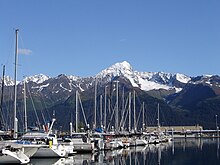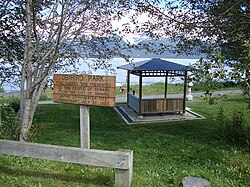Seward, Alaska
Seward, Alaska | |
|---|---|
| Welcome sign Welcome sign | |
 | |
| Country | United States |
| State | Alaska |
| Borough | Kenai Peninsula |
| Established | 1903 |
| Incorporated | 1912 |
| Government | |
| • Mayor | Willard Dunham Term Expires 10/2011 |
| Area | |
| • Total | 21.5 sq mi (55.8 km2) |
| • Land | 14.4 sq mi (37.4 km2) |
| • Water | 7.1 sq mi (18.4 km2) |
| Elevation | 0 ft (27 m) |
| Population (2000) | |
| • Total | 2,830 |
| • Density | 196.0/sq mi (75.7/km2) |
| Time zone | UTC-9 (Alaska) |
| • Summer (DST) | UTC-8 (Alaska) |
| ZIP code | 99664 |
| Area code | 907 |
| FIPS code | 02-68560 |
| GNIS feature ID | 1414598 |
| Website | www.cityofseward.net |
| Source of coordinates Template:GR | |
Seward is a city in Kenai Peninsula Borough in the U.S. state of Alaska. According to 2005 Census Bureau estimates, the population of the city is 3,016.[1]
It was named after William H. Seward, United States Secretary of State under Abraham Lincoln and Andrew Johnson. In 1867, he fought for the U.S. purchase of Alaska which he finally negotiated to acquire from Russia.
In 1793 Alexander Baranov of the Shelikhov-Golikov company (precursor of the Russian-American Company) established a fur trade post on Resurrection Bay where Seward is today, and had a three-masted vessel, the Phoenix, built at the post by James Shields, an English shipwright in Russian service.[2]
Geography

According to the United States Census Bureau, the city has a total area of 21.5 square miles (55.8 km²), of which, 14.4 square miles (37.4 km²) of it is land and 7.1 square miles (18.4 km²) of it (32.93%) is water.
Adjoining communities include Bear Creek and Lowell Point.
Economy

- Seward is the seventh most lucrative fisheries port in the United States per value. In 2004, 49.7 million dollars worth of fish and shellfish passed through Seward according to the National Marine Fisheries Service.
- Another major industry in Seward is tourism.
- Seward is also an Alaska Railroad terminus which has a maintained dock for cruise vessels and it controls a shipping terminal for coal from Usibelli. The Railroad and Aurora Energy Services employ dozens of people in the local area.
Demographics
As of the censusTemplate:GR of 2000, there were 2,830 people, 917 households, and 555 families residing in the city. The population density was 196.0 people per square mile (75.7/km²). There were 1,058 housing units at an average density of 73.3/sq mi (28.3/km²). The racial makeup of the city was 72.12% White, 2.44% Black or African American, 16.68% Native American, 1.84% Asian, 0.18% Pacific Islander, 0.88% from other races, and 5.87% from two or more races. 2.40% of the population were Hispanic or Latino of any race.
There were 917 households out of which 35.7% had children under the age of 18 living with them, 44.6% were married couples living together, 12.1% had a female householder with no husband present, and 39.4% were non-families. 30.8% of all households were made up of individuals and 7.1% had someone living alone who was 65 years of age or older. The average household size was 2.40 and the average family size was 3.04.
In the city the population was spread out with 21.9% under the age of 18, 9.0% from 18 to 24, 35.9% from 25 to 44, 25.7% from 45 to 64, and 7.5% who were 65 years of age or older. The median age was 37 years. For every 100 females there were 150.2 males. For every 100 females age 18 and over, there were 166.6 males.
The median income for a household in the city was $44,306, and the median income for a family was $54,904. Males had a median income of $36,900 versus $30,508 for females. The per capita income for the city was $20,360. About 8.3% of families and 10.6% of the population were below the poverty line, including 12.7% of those under age 18 and 7.9% of those age 65 or over.
| Year | Population |
|---|---|
| 1920 | 700 |
| 1930 | 800 |
| 1940 | 900 |
| 1950 | 2,100 |
| 1960 | 1,900 |
| 1970 | 1,600 |
| 1980 | 1,800 |
| 1990 | 2,700 |
| 2000 | 2,830 |

Government and infrastructure

The Alaska Department of Corrections operates the Spring Creek Correctional Center in Seward.[4][5]
The United States Postal Service operates the Seward Post Office.[6]
Transportation
This section needs additional citations for verification. (August 2010) |
Seward is unique among most small Alaskan communities in that it has road access in the Seward Highway, a National Scenic Byway and All-American Road, which also brings it bus service. Seward is also the southern terminus of the Alaska Railroad. This keeps the port busy with freight coming on and off the trains, but also makes Seward a primary end point for north-bound cruise ships. Cruise ship passengers get off the boats and take the train farther north to Denali or other Alaskan attractions.
Seward is a very bike friendly community. A paved bike path runs from the downtown business district through the harbor and along the highway to mile 4.5. Bikes are available for rent and there are even guided bike tours of the area [2].
Seward used to receive service from the Alaska Marine Highway (ferry) system, however, service was discontinued at the end of the 2005. Ferry connections are now available in Whittier (90 miles North) or Homer (150 miles by highway).
Seward Airport (PAWD/SWD) is home to (general aviation) services and flight-seeing operators. Scheduled commercial service is available at Kenai Municipal Airport in Kenai and Ted Stevens Anchorage International Airport, both about 100 miles (160 km) away. Seasonal bus connections are also available.
International sister cities

Notable people from Seward
- In 1927, thirteen-year old Seward resident and Native Alaskan, Benny Benson, won a territory-wide American Legion contest to design a flag for Alaska. Born in Chignik in 1913, he was three when his mother died of pneumonia. Soon after her death the family's house burned and his Swedish fisherman father sent Benny and his brother to the Jesse Lee Home in Seward. Winning the contest changed Benny’s life. The prize for designing the flag included a $1000 scholarship which he used to become an airplane mechanic. He married, raised a family, and died of a heart attack in 1972 at the age of 58. His design became the territorial flag and eventually the state flag. He is memorialized in Seward by the Benny Benson Memorial Park.[7]

- Chad Bentz, Major League Baseball Player
- Harry Kawabe, Japanese-American businessman sent to internment camp during WWII
Points of interest

- Mount Marathon and its famous Mount Marathon Race
- Kenai Fjords National Park with its easily accessible Exit Glacier
- Alaska SeaLife Center
- Sport fishing- Salmon, Halibut, Ling cod, Salmon Shark
- Glacier and Wildlife Day Cruises
- Kayaking
- Sailing
- Hiking
- World class mountain bike trails
- 4 July Celebrations
- Silver Salmon Derby
- Alaska Vocational Technical Center
- 4th of July Festival
- Seward Silver Salmon Derby
- Seward Polar Bear Jump-Off
- Seward Music and Arts Festival, every year in September.
- Kenai Fjord Tours, take an amazing boat cruise into the Kenai Fjord National Park.
References
- ^ "Annual Estimates of the Population for All Incorporated Places in Alaska" (CSV). 2005 Population Estimates. U.S. Census Bureau, Population Division. June 21, 2006. Retrieved November 9, 2006.
- ^ Haycox, Stephen W. (2002). Alaska: An American Colony. University of Washington Press. p. 82. ISBN 9780295982496.
- ^ [1]
- ^ "City of Seward 2020 Comprehensive Plan Volume II." City of Seward. 94/97. Retrieved on August 15, 2010.
- ^ "Spring Creek Correctional Center." Alaska Department of Corrections. Retrieved on August 15, 2010.
- ^ "Post Office™ Location - SEWARD." United States Postal Service. Retrieved on August 15, 2010.
- ^ University of Alaska. "Alaska State Flag, and Song, Intertwined Around Benny Benson." UA Informational Highlights. University of Alaska, Statewide Office of Public Affairs. Retrieved on 2007-04-29.
External links
- City of Seward in Alaska
- Seward Information Center
- Seward Chamber of Commerce and Conference & Visitors Bureau
- SewardCityNews.com Seward's citizen journalism site
- Seward, Alaska at Curlie


